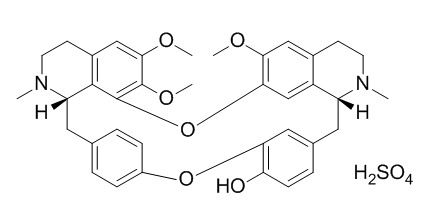Oxyacanthine sulfate
Oxyacanthine can be used for the treatment of various inflammatory diseases such as lumbago, rheumatism and to reduce fever.
Inquire / Order:
manager@chemfaces.com
Technical Inquiries:
service@chemfaces.com
Tel:
+86-27-84237783
Fax:
+86-27-84254680
Address:
1 Building, No. 83, CheCheng Rd., Wuhan Economic and Technological Development Zone, Wuhan, Hubei 430056, PRC
Providing storage is as stated on the product vial and the vial is kept tightly sealed, the product can be stored for up to
24 months(2-8C).
Wherever possible, you should prepare and use solutions on the same day. However, if you need to make up stock solutions in advance, we recommend that you store the solution as aliquots in tightly sealed vials at -20C. Generally, these will be useable for up to two weeks. Before use, and prior to opening the vial we recommend that you allow your product to equilibrate to room temperature for at least 1 hour.
Need more advice on solubility, usage and handling? Please email to: service@chemfaces.com
The packaging of the product may have turned upside down during transportation, resulting in the natural compounds adhering to the neck or cap of the vial. take the vial out of its packaging and gently shake to let the compounds fall to the bottom of the vial. for liquid products, centrifuge at 200-500 RPM to gather the liquid at the bottom of the vial. try to avoid loss or contamination during handling.
Fitoterapia.2024, 175:105955.
Biochem Biophys Res Commun.2018, 495(1):1271-1277
Front Pharmacol.2023, 14:1244655.
J Sci Food Agric.2022, 102(4):1628-1639
Pamukkale Medical Journal2022, 15(4):796-803.
Mol Biol Rep.2024, 51(1):117.
Neurochem Int.2023, 167:105537.
Food Funct.2024, 15(4):1852-1866.
Talanta Open2023, 7:100227
Fitoterapia.2022, 105141.
Related and Featured Products
Life Sciences, 2002, 72(6):645-657.
A comparative study on the anti-inflammatory, antinociceptive and antipyretic effects of isoquinoline alkaloids from the roots of Turkish Berberis species.[Reference:
WebLink]
Roots and barks of various Berberis species are used as folk remedy for the treatment of various inflammatory diseases such as lumbago, rheumatism and to reduce fever.
METHODS AND RESULTS:
Six isoquinoline alkaloids namely berberine, berbamine, palmatine, oxyacanthine(Oxyacanthine sulfate), magnoflorine, and columbamine were isolated as the main components of alkaloidal fraction from the roots of Turkish Berberis species and effects were studied using various in vivo models in mice.
CONCLUSIONS:
All alkaloids inhibited inflammations in varying degrees, among them berberine, berbamine and palmatine were shown to possess significant and dose-dependent inhibitory activity against serotonin-induced hind paw oedema both on oral and topical applications and acetic acid-induced increase in vascular permeability on oral administration. Moreover, these three alkaloids were also shown to possess dose-dependent antinociceptive activity, which assessed by using the model based on the inhibition of p-benzoquinone-induced writhing movements as well as antipyretic activity on FCA-induced increased rectal temperature on subacute administration. However, all alkaloids induced gastric lesions in varying degrees.



